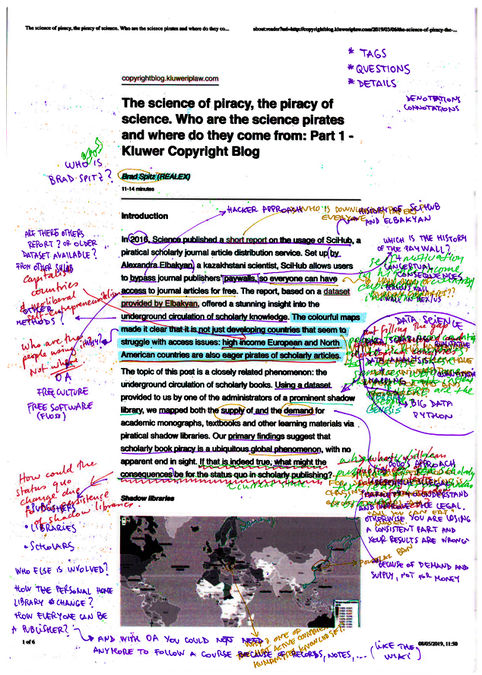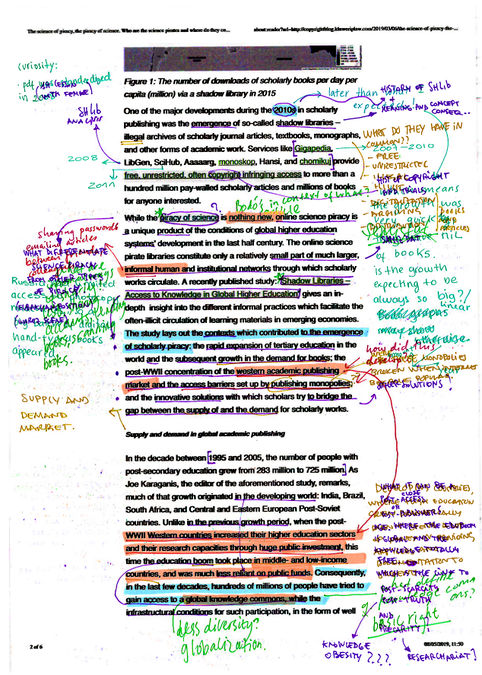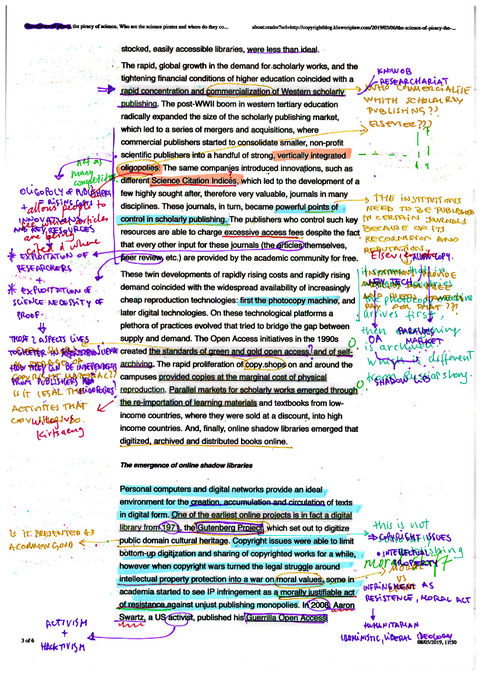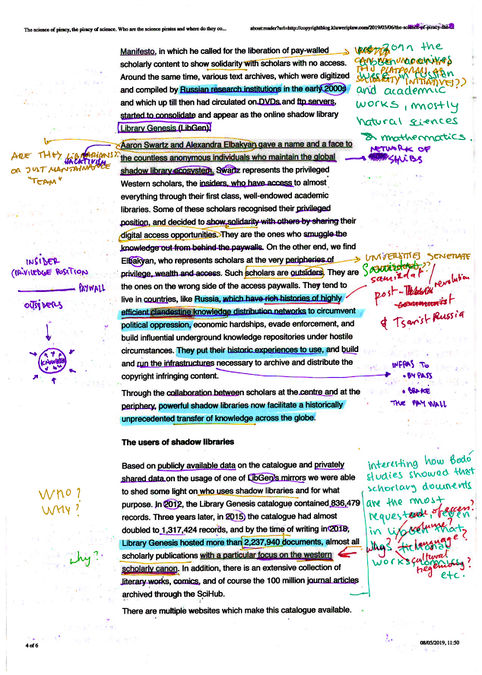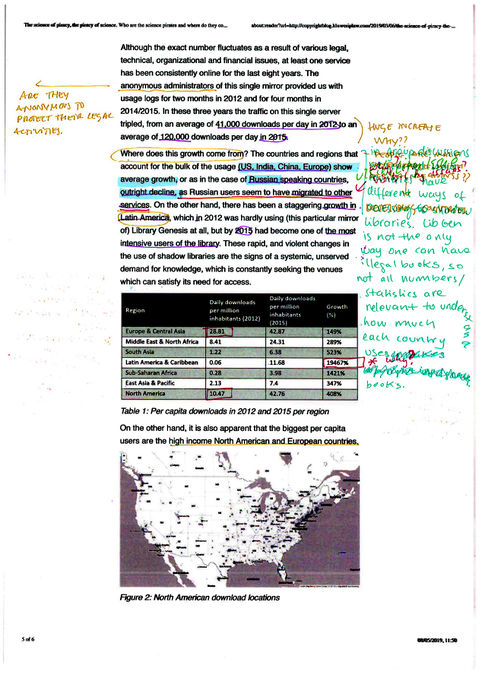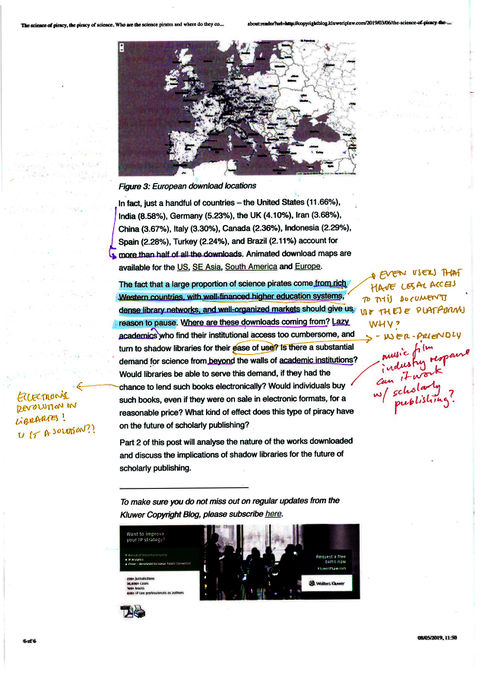User:Bohye Woo/RW&RM 03
Wednesday 17 April
- Content : What is in the library? How much?
- Users: Who is using / uploading / downloading?
- Catalog: What is the system? How is it organised? How about its ontology?
- Infrastructure: What are technical specs? Software? Hardware?
- Politics: What is the attitude?
- Economy: Sponsors? Donation? Advertising?
- Law: How does it interface?
MEMORY OF THE WORLD https://www.memoryoftheworld.org/
- Content : What is in the library? How much?
136241 books, 16 shown Have books 50s - 90s Politics-History-Theory, Eastern European, post-communism Scanned and uploaded books from "librarians" of this library Plugin, that you could share from calibre, your local network's library
- Catalog: What is the system? How is it organised? How about its ontology?
Using Callibre Listed by format/title/tag/date Book on their server?
Abstract
Memory of the World is a web-based public library, where you find books in PDFs, ePUB provided by the individual online librarians. The library concentrate on the subject of politics-history theory, eastern European, post-communism between 50s and 90s indexed by author, title, tag, date and format. Currently, there are 136,255 books available from 19 librarians online on the web, it might change when more librarians join the network or when they loose the connection. It has the vision that the world’s documentary heritage belongs to all, should be fully preserved and protected for all and, with due recognition of cultural mores and practicalities, should be permanently accessible to all without hindrance. When the librarians are online, you can access to the so-called "a personal digital library" where they randomly share the selection of books. The selection of books are depending on the librarian's choice, which they provides information such as title, authors, publisher, and small description with PDFs or EPUB. The library is publicly open, although the librarian's personal information are perfectly secured. You can use a plugin shared from Calibre, an open-source suite of e-book software, from their local network's library.
Questions
Who does the library serve?
What does ownership and curatorship mean in a shadow library?
How does it make a difference to transfer the role and the presence of a "librarian" into a web library?
Does the background of the librarian affect the content presented on a library?
Who does the library serve?
What could be the motivation to make such a library?
What values does it communicate?
Who is responsible and what are they responsible for?
What is it filtered out and what are the political implications of that?
MONOSKOP https://monoskop.org/
Monoskop Wiki: selection of different themes Monoskop Log: is a digital library of arts and humanities.
like a wikipedia page avant-gardes, media arts and theory and activism a blog repository featuring
Monoskop is a wiki, and a repository aggregating, documenting and mapping works, artists and intiatives related to the avant-gardes, media arts and theory and activism. Initially it focused on Eastern and Central Europe. Built on a Wiki that everyone can contribute to and scrupulously curated by its spiritus movens Dušan Barok, it provides both an exhaustive, indexical overview of those fields and provides digital access to rare historic finds. In parallel to the wiki, Monoskop maintains a blog repository featuring daily releases of books, journals or other printed archival material, some digitized by Monoskop and some contributed by the users, authors and publishers. Pdfs are available to download, while there are also links to other shadow libraries which host this content.
Pdfs available to download, also redirecting in other (public) libraries that host this content
Monoskop & copyright https://monoskop.org/About_Monoskop#Copyrights
Abstract
Monoskop is a Wiki and a Log (repository), aggregating, documenting and mapping works, artists and initiatives related to the avant-gardes, media arts, theory and activism. Initially it focused on Eastern and Central Europe. Built on a Wiki that everyone can contribute to and thoroughly curated by Dušan Barok, who initiated the project, Monoskop provides both an exhaustive, indexical overview of studies of art, media and the humanities, and provides digital access to rare historic finds. In parallel to the Wiki, Monoskop maintains a blog repository featuring daily releases of books, journals or other printed archival material, some digitized by Monoskop and some contributed by the users, authors and publishers. Pdfs are available to download directly, but there are also links to other shadow libraries, which host relevant content. Monoskop runs on MediaWiki software, and is hosted by the Sanchez free art server, maintained by Multiplace. The largest part of the content is formed by top 500 thematic tags from Monoskop Log, each linking full-text publications, mostly books, while some themes also have dedicated wiki pages. The 100 persons--artists, makers and writers--are linked to wiki pages consisted primarily from chronologies and bibliographies of their work, some accompanied with biographies.
Questions
Who does the library serve?
What could be the motivation to make such a library?
What values does it communicate?
How is it different if you can participate in editing the content of a library, compared to just be a viewer-receiver of the content?
How is it valuable to have carefully and thoroughly edited content in a library?
How can a shadow library defend itself legally, related to the kind of content it provides?
PROJECT GUTENBERG
Abstract
Project Gutenberg, initiated in 1971 by Michael Hart, is the world's oldest digital library of "eBooks", that is, books that are available electronically as PDFs, HTML, ePUB and plain text format. The collection has more recently expanded to include audio books, and texts in a variety of languages other than English. On the wiki-based website www.gutenberg.org, more than 58,000 eBooks are indexed by author, title, language and "recently posted". The search function allows users to look for titles by US Library of Congress search terms, as well as by going through Google and Yahoo metadata. The majority of these books are within the public domain and therefore free from copyright restrictions, although undoubtedly there are some that are orphaned by subsequent changes to US copyright terms (which in most cases of published texts, is now 70 years after the death of the author). Due to this, as well as differences in copyright law internationally, the complete legal legitimacy of its collection is in question, despite careful attempts to comply with US copyright law. It is important to note that Project Gutenberg is a project, rather than a single library, with sister affiliations in many countries (Project Gutenberg Australia, Project Gutenberg Europe among many others). This, alongside its non-profit stance (Project Gutenberg accepts donations, and also calls for volunteer help with proofreading and digitization of books, as well as recording audio books) lends moral legitimacy to its online distribution of texts.
Questions
Looks like a clasic collection; the interface is classic; based on a wiki; speaks of legitamacy
Who is responsible and what are they responsible for?
This is all the stuff that's in the public domain...
What could be the motivation to make such a library?
What values does it communicate?
Good. Air of legitimacy; “library of congress search terms” and google to collect information. On this way they seek legitimacy from the on-line and off-line agents.
What do they mean 'a project'? (is this an agent of legitimacy?) Involves many people; projects into the future; mutable (not set in stone)
What is it filtered out and what are the political implications of that?
How does the codex form limit what is available?
Who does the library serve?
Who is responsible and what are they responsible for?
AAAAARG.FAIL
Abstract
Out of the necessity for a library, for artist Sean Dockray's LA-based educational institution called "The Public School", aaaaarg.fail (formerly aaarg.org, then aaaarg.org) is a website that hosts a collection of mostly theory and critical theory texts, and an online forum for members. Access to the collection comes from registering an account (you must be invited by a member first). Members can upload and download texts, as well as request titles via the forum. The changes in the domain name for the library come from repeated copyright infringement allegations from publishers of works that have been made accessible on the site, including the Australian publisher Macmillan. The publisher hired Mark Taylor, a former music industry executive, who was instrumental in bringing forth a cease and desist order against aaarg.org. Dockray later called this "another case where university students are conceived of as consumers, as carriers of debt for everything from degrees to consumer electronics to intellectual property" (http://unprojects.org.au/magazine/issues/issue-4-2/the-future-and-the-public-school/ ).
Questions
Who does the library serve? (who are the customers?)
Intellectual snobs.
You have to be invited
Forum? What affordance does that give?
Sociability? There is a set of manners
The forum produces a text (a form of collective annotation); a discussion on the texts in the library. Because you can make requests it is much more personal. You can also select by "most requested", which means that a hierarchy of information is produced within the forum.(by the discussion of the members)
How is it different if you can participate in discussing the content of a library, than just be a viewer-receiver of the content?
Who is responsible and what are they responsible for?
How is it different to be an exclusive member in order to have access to the content of a library, compared to have no restrictions in accessing it?
How does the collection (and discourse around it) represent the members of the library?
If the library is based on user requests, it's a mirror of the members interests/social status/credentials/ideologies/clout
Does this platform require a certain degree of library literacy and research skills?
Does the background of the librarians affect the content presented in a library?
UBUWEB.COM
Abstract
UbuWeb.com is a large web-based, free, non-commercial resource for avant-garde poetry, music, film, literature and more, founded in 1996 by poet Kenneth Goldsmith. It offers visual, concrete and sound poetry, expanding to include film and sound art mp3 archives. The site's architecture limits retrieval to keyword searching and browsing by media type and artist/project name. In addition, sustainability is a concern for this website as it was never intended to be a permanent archive. Still, there is no comparable commercial source for the content on UbuWeb so it is valuable as a resource for libraries to point users toward so long as librarians are aware of its limitations. It is a library which is ever-expanding in uncanny—and often uncategorizable—directions. Each section has an editor who brings to the site their area of expertise. UbuWeb is not n to any academic institution, instead relying on alliances of interest and benefiting from bandwidth donations from its partnerships with GreyLodge, WFMU, PennSound, The Electronic Poetry Center, The Center for Literary Computing, and ArtMob. UbuWeb was founded in response to the marginal distribution of crucial avant-garde material. It remains non-commercial and operates on a gift economy. UbuWeb ensures educational open access to out-of-print works that find a second life through digital art reprint while also representing the work of contemporaries. It addresses problems in the distribution of and access to intellectual materials.
Questons
Who does the library serve?
What could be the motivation to make such a library?
What values does it communicate?
How can the material available in a library shape the discourse around a particular field?
Wednesday 22 May — Collective Anotation
note
Anonymity and acknowledgment on (hidden) (digital) labor in shadow library
Authorship - economy
Subjective of categorization as a form of annotation
Labour - collectivity?
How metadata is edited in this libraries and how is the work that is behind that
Harvesting of full metadata sets from libgen for example
- Relation between authorship and work.
- Anonymity vs acknowledgment.
Story?
Thinking about authorship in the context of hidden labour in shadow libraries, I question what does it mean to possess authorship when an act of pirating is happened, how can authorship be made, what are hidden accumulated labours that we don't see physically. These labours are made by sharing, editing, scanning, modifying, downloading files, however, these materials are usually not being considered as part of 'content' as annotation, it is considered to be ignored or intentionally hidden. What, Why, and how are they hidden, how can we divulge? Do we want to acknowledge on our labour or leave it anonymously?
Method? (How to?)
— Stretching the Idea of Shadow(ing): The meaning of shadow is an area of darkness, being blocked by something, and being unofficial. And the meaning of Shadowing is a method for observing the ultrastructure of biological specimens by increasing visibility of electron microscope in order to see cells minutely. If I think of 'Shadowing' in the context of hidden labour in shadow libraries, an act of shadowing is that zooming-in the invisible layer of the library to witness traces of what is being hidden.
Workshop?
Knowledge labour in the pirate library/ Being a knowledge labourer means to download, to edit, to modify, and to upload files — finding out what labours were spent when pirating.
How?
Diving into a forensic way of investigation on labour: In order to reveal the hidden labour in shadow library, Participant will be a detective to find digital labour footages. Being in a detective mode, we'll track down traces/labours that are made throughout the process of select, copy, scan, upload, download, modify, edit, categorize files and put metadata etc...
New knowledge?
Being as a knowledge labourer, you are aware of thinking on the concept of acknowledgment on hidden labours in shadow library.
A role of annotation?
Annotation becomes a tool to acknowledge hidden labour produced in shadow libraries. It will be considered as more like a investigation(workshop) report on revealing the hidden labour.
Aim?
To experience the behind scene of what's going on in pirate libraries To be aware of legality, anonymity, and acknowledgment. To find out what possible digital labours were being hidden, and why is it important to think of? To understand anonymity in pirating and acknowledging its authorship.
Tool?
Exiftool
Post-Workshop Session - Interviewing with Dusan
Who is Dusan Barok
INTRODUCTION
Dušan Barok is a researcher, artist, and cultural activist involved in critical practice in the fields of software, art, and theory. Graduated in information technologies from the University of Economics of Bratislava, he then moved to the Netherlands to complete Networked Media masters course at the Piet Zwart Institute in Rotterdam, to finally land in a doctorate in the preservation of contemporary art in Amsterdam. He is best known for Monoskop (monoskop.org), a wiki for collaborative studies of the arts, media, and humanities, started in 2004 as a project to document and map media art and culture in the eastern part of Europe. It expanded toward arts and humanities to take its final form of a media library in 2012, as Dušan Barok's graduation project at the Piet Zwart Institute.
Monoskop is a wiki for collaborative studies of the arts, media and humanities, started in 2004 as a project to document and map media art and culture in the eastern part of Europe. In one year it expanded toward arts and humanities to take its final form of media library in 2012 as Dusan Barok's graduation project in the Networked Media master course of Piet Zwart Institute. The wiki provides an indexed collection of information, materials and links around those fields, focusing on less-known phenomena. While the parallel project called Monoskop Log, release digital books and papers to create an exhaustive archive of resources directly linked to the wiki entry. Books are available in different formats and their digitization is done by Monoskop but also users can contribute or you can find the link to the original file usually from other digital libraries.
Letter to Dusan Barok
Hi Dušan,
Thank you for your reply. We're glad that you would like to take part in our interview. Sorry that we're in a hurry but we will start the production of the publication from the 8th of this month. We were wondering what would be best for you to further talk with us. We'd like to meet you in person to have a conversation, however, we understand that it's not the most convenient period for that. So, we would like to suggest that we could either do an online video call session, or we could receive answers by email. Our questions are between the lines below, along with a small introduction about you and Monoskop that we'd like to include in our publication. If you'd like to make any changes or comments on this bio and/or our questions, please feel free to do so.
Thank you very much for your participation, and we're looking forward to hearing from you soon.
Best, Pedro, Tancredi and Bo
Reply
Hi all,
please find my responses below. Thank you again for your impulses, this was stimulating and thoroughly enjoyable. Hopefully my writing makes sense, perhaps some parts are too condensed and not clear enough.. feel free to clean the text where you find appropriate, but it's also superfine if you just leave it as it is since I guess there's not much time left. If you're thinking about images/illustrations and there's still time, I would have a few tips (mostly from the URLs included in the text) but also would be happy to leave choices to you.
Dušan Barok is a researcher, artist, and cultural activist involved in critical practice in the fields of software, art, and theory. Graduated in information technologies from the University of Economics of Bratislava, he then moved to the Netherlands to complete Networked Media masters course at the Piet Zwart Institute in Rotterdam, to finally land in a doctorate in the preservation of contemporary art in Amsterdam. He is best known for Monoskop (monoskop.org), a wiki for collaborative studies of the arts, media, and humanities, started in 2004 as a project to document and map media art and culture in the eastern part of Europe. It expanded toward arts and humanities to take its final form of a media library in 2012, as Dušan Barok's graduation project at the Piet Zwart Institute.
The wiki provides an indexed collection of information, materials, and links around those fields, focusing on less-known phenomena, while the parallel project called "Monoskop Log", releases digital publications to create an exhaustive archive of resources directly linked to the wiki entries. Books are available in different formats and their digitisation is done by Monoskop but also users can contribute or one can find the link to the original file usually coming from other digital libraries.
1. As the librarian of Monoskop, do you feel the responsibility to regularly share new files and improve how they are organised?
I use Monoskop almost on a daily basis, keeping trace of my focused or less focused browsing, reading and live encounters. A wiki, as a read-write website, really is a cool medium in McLuhan's sense. Its pages are never complete, they demand continuous updates, and being linked to one another, often it is a chain reaction, an idiosyncratic process of rereading and rewriting and following what others edited and contributed to the site. It is a messy process, by now a habit perhaps, with no end in sight, a compendium of temporary interests, passions and exchanges.
At the same time there certainly is a responsibility. The website has been part of Google and other search indexes and it does have a share in bringing people, ideas and things in focus, into attention. The responsibility here is to unveil, unearth what is not established, prominent, what is urgent, bring about new relations and contexts, burst bubbles. Our language and communication will always be narrative, a succession of signs, but we've made a long way from the primacy of a book as the basic unit of knowledge. Imagine you are not running a library but a search engine, operating in a field governed by the logic of an index and the mechanics of bots. Or that you are running a content farm, in the world where the only content that matters is either a massive dataset or a viral tidbit of information.
2. Digitising books involves decisions on how to manage human and non-human traces present in the physical book. When you select a book, do you follow any rules to manage those traces?
When scanning a book I try to enter at least basic metadata into the file, including title, author, producer, date of scanning and source of the volume. Many books I've scanned contain marginalia and highlights. I like to preserve them, which is part of the reason to scan in full color, albeit I am also aware that for some they can be distracting. They are usually personal, notes to self, rarely intended for a wider audience. Still I prefer to stay true to the original copy and its materiality.
I like to use old-school scanners for results have their own, perhaps by now vintage aesthetics. I say old-school because of course today it is more apt to use overhead scanners with digital cameras. Currently I am collaborating with artist Ilan Manouach, building a collection of conceptual comics [1], consisting mostly of works published in the past ten years. Ilan has built his own overhead scanner and photographs books with pages open, which opens up for a special physical experience. Rather than creating ready-to-print digital copies, these PDFs may be experienced on tablets and digital frames, emphasising the "visuality" of these works.
3. In the Monoskop catalog, we have found books such as "Umenie dnes" by Tomáš Štraus (for example, page 3, 158, and 172) where the digital copy contains marks from the physical source. When did this preoccupation start and what does it mean for you to explore the processes in the margins of readable sources?
This scan [2] was made as part of our "Unlimited Edition" series of digital editions of rare but important works from art history. The PDF file has coins, Czechoslovak crowns, placed on some of the pages, totaling the original price of a copy of the book. I think it was an attempt to address the relations between value, historicity and distribution. One thing is the virtue of bringing an out-of-print volume back into distribution, another is the radically different context in which this happens. The act of digitisation is often viewed as automated and neutral, but of course, as you said, there are many decisions involved along the line. One can clearly see it when comparing digital reproductions of a single volume made by different individuals and institutions. Our part is to question the logic of assembly line so tightly attached to the digitisation of art, knowledge and heritage.
4. Archives such as the Archive of the Avant-gardes in Dresden where you were involved, are starting to implement digital archives for their collections. However, the historical memory of the physical item with its time frame within a specific archive and its spatial position in it are not represented, showing a loss of criticism in the relation between materials, institutions, and people involved in its fruition. Do you think is it important to keep this historical information in the digital implementation of a collection?
It is by now well acknowledged that a printed document and its digital copy is not the same thing, their properties are different. But besides the politics of file formats and optical character recognition, there is a whole range of other issues which are subject to different affordances and interests in the digital domain. What struck me in researching the Archiv der Avantgarden (AdA) in Dresden was the palpability of contextual framework imposed by the institution of a collection upon included items, and the (however unintentional) role of the digital version of the collection to obfuscate this imposition. The archive follows, rather strictly, a certain structural logic, invented and applied to it by its original owner before the archive has been transformed into a public institution. The order has been inspired by and expanded upon the book 'Kunstismen' by El Lissitzky and Hans Arp [3] in which they represented some of the avant-garde movements of the era by various "isms". The collector had been active mainly from the 1960s through the 1980s this era obviously left its marks on the structure. You have to spend some time in the archive before the logic and structure really comes forth and gets revealed to you in full. It is very hard, if not impossible to let this happen in the digital realm. But this is where most people will access and experience it after the archive gets published online. There it won't be so obvious to notice that it almost solely represents male artists from the Western world and equally hard it will be to understand why, as this logic has also played a role in acquisitions. What kept on resurfacing during our research (there were about 60 researchers involved in the project) was the will of the AdA team to "fill the gaps". Here, a digital archive comes to help cover the traces as well. Once new acquisitions enter the archive, they will merge with the rest of the collection, as if they have always been there. A website seemingly erases the past and presents the current state of the collection as the ever-lasting one. The takeaway here is that a digital archive provides access to cultural memory but it tends to lack memory of itself; and while it provides access to world's memory, it tends to do so out of nowhere. What do we do about it?
5. Some of the books in Monoskop Log are linked to the digital library of origin; what is your intention in providing this kind of historical path of the file? Do you keep track of the viability of these links?
It is often about finding a right balance between acknowledging and protecting sources. When I am unsure I try to ask, although I am more happy when Monoskop serves really as one point in the path of a file so that one can trace it back to where it came from. Perhaps we can think of distribution along the lines of citation practises. As we said earlier, there is work and decisions involved in digitisation, and linking sources adds to both credit and accountability.
6. In your 2013 interview for the Neural Magazine you say that takedown notices are often a reality for Monoskop. Do you keep records of which books you were asked to remove, and by whom you were asked to do it? Do you think this kind of practice could reveal valuable information on how free access to texts is tracked by publishers and how to escape systematic control?
Yes we do keep records and try to be very open about it. As a rule, the entries on Monoskop Log are preserved even after the actual files are removed. I usually leave a note about the date and the subject who asked for deletion. This marks a part of the path of the book, even if it reaches a dead end in this case.
7. Monoskop explores the condition of digital books but it is a project also related to the evolution of art in its most contemporary and digital forms. In terms of your doctoral studies in the preservation of contemporary art, what is the relation between digital artworks and digital books? Should their processes of conservation and reproduction be addressed in the same way?
That's a good question, I haven't thought about it that way yet. As it happens, it is more straightforward to archive and preserve single files such as digital books in PDF and EPUB. This has been a crucial part of our work on Monoskop. However, many publications and other works are websites and similar assemblages of code and data, written in multiple programming languages with various software dependencies and consisting of many files and pages, oftentimes running on top of relational databases. Here we rely on the Internet Archive's Wayback Machine. When an online work comes down, one can almost always find its archived version on the Wayback Machine and this is what I usually do myself when I want to update a dead link to a website. I am aware there is too much at stake, and fields such as the preservation of software-based art do have much to offer here. Libraries where crawling and scraping meets emulation and virtualisation? Yes please!

